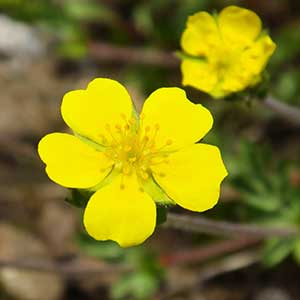Potentilla versicolor
Potentilla effusa
Steens Mountain cinquefoil, varying cinquefoil
branch cinquefoil
prostrate to ascending, (0.7–)1.5–2.5(–4) dm, lengths 2–4(–5) times basal leaves.
(0.5–)1.5–4(–5.5) dm, lengths 2–3(–4) times basal leaves.
pinnate with distal leaflets ± confluent, 4–12 × 1–2.5(–3.5) cm;
petiole 1–3 cm, straight hairs absent (on early-season petioles) or sparse to common, spreading-ascending to loosely appressed, 1–2 mm, soft, cottony hairs usually absent, glands sparse;
primary lateral leaflets 3–5 per side, on distal (1/3–)1/2–2/3 of leaf axis, overlapping, largest ones cuneate to flabellate, 0.5–1.5(–2) × 0.5–1.5 cm, distal 3/4 to whole margin unevenly incised 2/3 to completely to midvein (blade often medially split as well), ultimate teeth or segments 2–5(–8), ± oblanceolate, 3–11 × 1–3 mm, apical tufts to 1 mm, surfaces green to grayish green, not glaucous, straight hairs sparse to common (sparser adaxially), sometimes absent (except on margins), loosely appressed to ascending, 1–2 mm, soft, cottony hairs absent, glands sparse to common.
pinnate, (3–)5–15(–25) cm;
petiole 0.5–5(–8) cm, long hairs absent to abundant, ± appressed, 1–3 mm, stiff to weak, short and crisped hairs absent or obscured, cottony hairs abundant (at least on first-formed leaves), glands sparse or obscured;
leaflets not conduplicate, lateral ones evenly to unevenly paired, 2–5(–7) per side (secondary leaflets sometimes interspersed) on distal 1/3–1/2 of leaf axis, distal pairs usually not decurrent or confluent with terminal leaflet, larger leaflets oblanceolate to narrowly obovate, 1–2.5(–3) × 0.3–1.3(–1.8) cm, distal (1/2–)2/3–3/4 (rarely more) of margin incised ± 1/2 to midvein, teeth (1–)2–9 per side, 1–4 mm, surfaces similar, gray to white or ± green, abaxial: long hairs sparse to common (at least on veins), 0.5–1.5 mm, weak to stiff, short or crisped hairs absent or sparse, sometimes obscured, cottony hairs absent or sparse to dense, glands absent, sparse, or obscured, adaxial: long hairs absent or sparse to common, short or crisped hairs absent or sparse, cottony hairs absent or sparse to abundant, glands absent or sparse.
1–2(–3).
2–6+.
(1–)3–10-flowered, usually openly cymose.
7–30-flowered.
1–3(–5) cm, straight to slightly recurved in fruit.
0.3–3 cm.
epicalyx bractlets lanceolate to elliptic, rarely ovate, 2–5 × 1–2 mm, sometimes apically toothed;
hypanthium 3–5 mm diam.;
sepals 4–7 mm, apex acute;
petals 4–7 × 3–5.5 mm;
filaments (1–)1.5–2.5 mm, anthers 0.5–0.8 mm;
carpels 10–25, styles 2 mm.
epicalyx bractlets linear to narrowly lanceolate, 1–2.5(–3) × 0.3–1 mm, 1/2–2/3 as long as sepals, abaxial vestiture often much sparser than sepals, often glabrate or glabrescent distally, straight hairs absent or sparse, cottony hairs usually abundant (at least proximally), sometimes absent or nearly so (var. rupincola);
hypanthium 2–6 mm diam.;
sepals 3–6(–7) mm, apex long acuminate;
petals 4–6.5 × 4–6 mm;
filaments 1–3.5 mm, anthers 0.5–1 mm;
carpels 3–15, styles 1.5–2.1 mm.
1.5–1.8 mm, smooth to faintly rugose, not carunculate.
1.8–2.1 mm, smooth.
Potentilla versicolor
Potentilla effusa
Potentilla versicolor is most common on Steens Mountain in Harney County, Oregon. Collections are known from other mountain ranges in eastern Oregon (some possibly representing distinct taxa) and from near Island Lake in the Ruby Mountains of northeastern Nevada. The species often grows and, apparently, intergrades with P. breweri; it is usually distinct in its lack of cottony hairs. Petals, filaments, and styles tend to be somewhat shorter in P. versicolor than in P. breweri. Collections of P. versicolor have most often been identified as P. breweri, P. millefolia, or P. ovina.
(Discussion copyrighted by Flora of North America; reprinted with permission.)
Varieties 2 (2 in the flora).
In the southern Rocky Mountains, Potentilla effusa is relatively distinct from P. hippiana both morphologically and geographically, with P. effusa mostly east of the Continental Divide and P. hippiana mostly west. In general, P. hippiana differs from P. effusa in having leaflets more evenly paired, more tightly serrate with teeth often occurring on the whole margin, and more bicolored with abaxial vestiture of crisped rather than cottony hairs. Stems of P. effusa have more cauline leaves on average than P. hippiana, and vestiture of epicalyx bractlets of P. effusa (as here circumscribed) is never sericeous.
The distinction between the two species is marred by intermediate populations throughout their shared range in the northern Rocky Mountains and Great Plains. Most regional floras focused on these areas have accordingly included Potentilla effusa within P. hippiana, sometimes without infraspecific distinction. An alternate solution has been the recognition of P. hippiana subsp. effusa, with the subspecies further subdivided into the two varieties recognized here. The varieties themselves intergrade; P. effusa var. ��coloradensis (Rydberg) Th. Wolf is available for the hybrid.
(Discussion copyrighted by Flora of North America; reprinted with permission.)
1. Leaflets gray to white, surfaces moderately long-hairy and moderately to densely cottony. | var. effusa |
1. Leaflets ± green, surfaces glabrous or sparsely to moderately long-hairy (at least on veins) and not or sparsely cottony. | var. rupincola |


